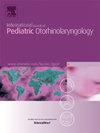Predictive factors of long-term tympanoplasty outcomes in children with cleft palate
IF 1.2
4区 医学
Q3 OTORHINOLARYNGOLOGY
International journal of pediatric otorhinolaryngology
Pub Date : 2025-06-13
DOI:10.1016/j.ijporl.2025.112429
引用次数: 0
Abstract
Objective
Identify factors associated with long-term tympanoplasty success in children with cleft palate.
Methods
All tympanoplasty procedures for chronic perforation in children with cleft palate at a single institution were reviewed over a 20-year period. Demographic and clinical characteristics were compared by tympanoplasty outcome – successful sustained repair versus reperforation or tympanostomy tube placement versus need for revision tympanoplasty – with univariate, survival, and multivariate analysis.
Results
A total of 50 initial tympanoplasty procedures for chronic perforation between 2004 and 2024 at a single institution met inclusion criteria of patients <18 years with a history of cleft palate, excluding revision and second-sided procedures. The overall success rate of primary tympanoplasty was 78 % with a mean length of follow-up of 5.7 (±3.6) years. Significant demographic and clinical predictors were not demonstrated by univariate analysis. However, survival analysis of time to tympanoplasty failure demonstrated differences in duration of successful tympanoplasty for children in which Eustachian tube function could be assessed by the status of the contralateral ear, with a mean time to failure of 10.7 [9.5–12.0] compared to 8.2 [5.3–11.0] years (p = 0.02). Ability to assess the contralateral ear was also associated with a 5.4 (1.1.-26.1) increased likelihood of a successful tympanoplasty outcome.
Conclusion
The success rate of tympanoplasty in children with cleft palate is lower than would be expected in an adult or non-cleft population, but can still be largely successful at a mean age of <12 years. The ability to assess the contralateral ear may the most important predictive factor in determining success rather than age, cleft type, or other demographic and clinical factors.
腭裂儿童长期鼓室成形术预后的预测因素
目的探讨影响腭裂患儿长期鼓室成形术成功的因素。方法回顾20多年来在同一医院治疗腭裂儿童慢性穿孔的所有鼓室成形术。人口统计学和临床特征通过鼓室成形术的结果进行比较——持续修复成功vs再穿孔或鼓室造瘘管置入vs需要鼓室成形术修复——单因素、生存和多因素分析。结果2004 - 2024年间,同一医院共有50例初次鼓室成形术治疗慢性穿孔,符合18年腭裂病史患者的纳入标准,不包括翻修和二次手术。原发性鼓室成形术的总成功率为78%,平均随访时间为5.7(±3.6)年。单变量分析未发现显著的人口统计学和临床预测因子。然而,对鼓室成形术失败时间的生存分析显示,通过对侧耳状态评估耳咽管功能的儿童成功鼓室成形术的持续时间存在差异,平均失败时间为10.7[9.5-12.0]年,而8.2[5.3-11.0]年(p = 0.02)。评估对侧耳的能力也与鼓室成形术成功的可能性增加5.4(1.1.1 -26.1)相关。结论腭裂儿童鼓室成形术的成功率低于成人或非腭裂人群,但在平均年龄12岁时仍可获得很大程度的成功。评估对侧耳的能力可能是决定成功与否的最重要的预测因素,而不是年龄、裂型或其他人口统计学和临床因素。
本文章由计算机程序翻译,如有差异,请以英文原文为准。
求助全文
约1分钟内获得全文
求助全文
来源期刊
CiteScore
3.20
自引率
6.70%
发文量
276
审稿时长
62 days
期刊介绍:
The purpose of the International Journal of Pediatric Otorhinolaryngology is to concentrate and disseminate information concerning prevention, cure and care of otorhinolaryngological disorders in infants and children due to developmental, degenerative, infectious, neoplastic, traumatic, social, psychiatric and economic causes. The Journal provides a medium for clinical and basic contributions in all of the areas of pediatric otorhinolaryngology. This includes medical and surgical otology, bronchoesophagology, laryngology, rhinology, diseases of the head and neck, and disorders of communication, including voice, speech and language disorders.

 求助内容:
求助内容: 应助结果提醒方式:
应助结果提醒方式:


